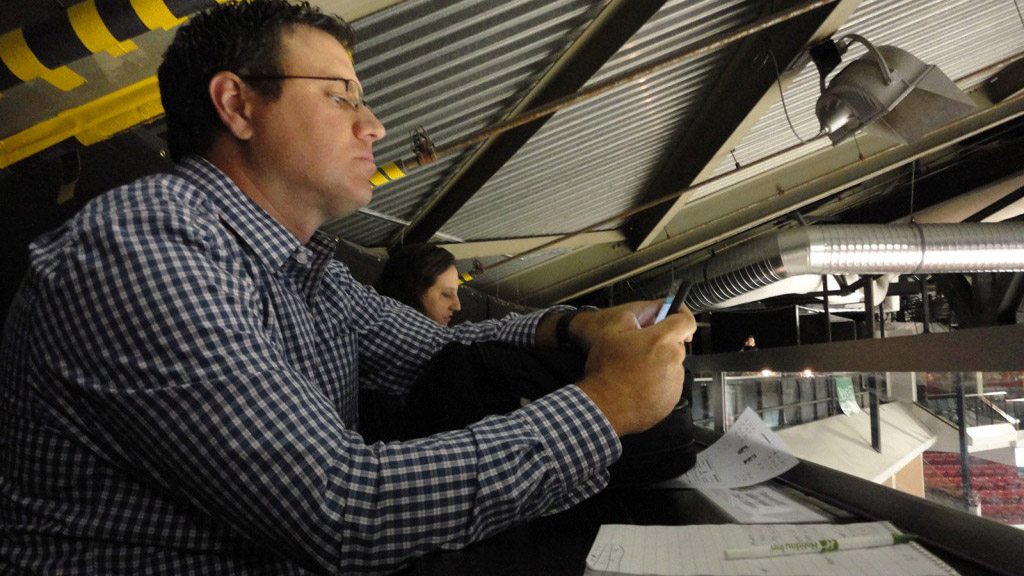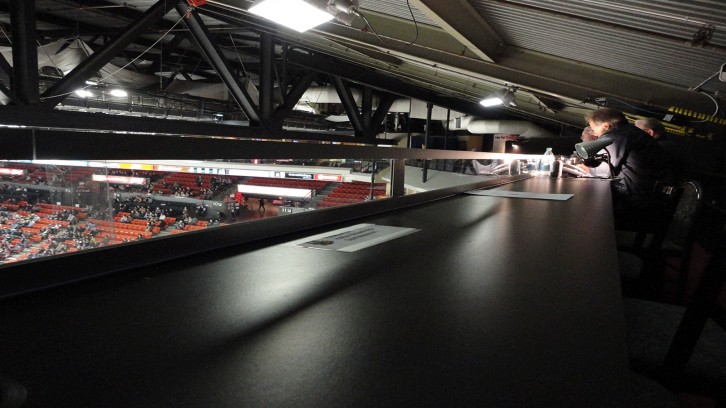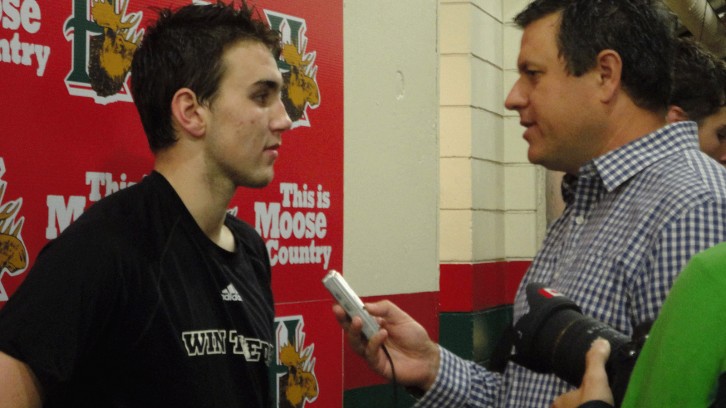More than just a game

caption
Chronicle Herald reporter Willy Palov in the press box.The “toy department” is battling to earn your respect
Three… two… one… the horn sounds, the whistle blows and the game is over. In the press box, high above the ice, laptops close with a click. Now the countdown to deadline begins.
“It’s difficult when the game is close,” says Willy Palov. “Especially when things can change in a split second or go into overtime.” Palov is a sports reporter for the Chronicle Herald in Nova Scotia. He covers a variety of sports, including junior hockey. You can find him in the press box at every Halifax Mooseheads home game.
Palov has an hour-and-a-half to deadline. He packs up his laptop, grabs his bag and throws out his empty can of pop before descending five flights of stairs to the locker room. There, Palov has a ten-minute window to interview players. He asks for key players, interviews them, adding quotes to his piece.
In journalism the term “toy department” is a running joke many journalists use to describe sports reporting. These journalists see sports reporting as fun and games, lacking any real weight.
“Fundamentally, the reason for the term ‘toy department’ is that sports are meant to be fun,” says John Affleck, the Knight Chair of Sports Journalism at Pennsylvania State University. “Sports depict human achievement versus the human failure of news.”
This isn’t your dad’s newspaper anymore.
Sports reporters tell you more than last night’s Toronto Maple Leafs score. Coverage is becoming more about what happens outside the game.
Injuries, crime, social issues and performance-enhancing drugs affect athletes. And the coverage of sports. It’s the media’s job to provide clarity. Without understanding these issues, sports journalists can’t fulfill their role.
Fun and games

caption
Press box at the Scotiabank Centre in Halifax, Nova Scotia.Penn State was the first of many North American universities to open a sports journalism program. In 2012, Penn State sports journalism graduate students conducted a survey in sports journalism programs across America. They found a 20 per cent increase of programs since 2007. Of the 452 journalism programs surveyed, 215 schools offer at least one sports journalism course. In 2007 only 14 programs provided a certificate, minor, emphasis or full program in sports communications. Now there are 34.
“Instead of taking the job because it’s open, journalists take jobs in sports because they’re prepared for and want sports,” said Affleck. “That creates a committed core of journalists in that department, helping to strengthen the newsroom.”
Despite this, terms like “toy department” are hard to escape. People associate sports with fun and games.
“I tell people it’s about more than covering Georgia football games,” says Vicki Michaelis, a professor of Sports Journalism at the University of Georgia. “The games are sort of the icing on the cake.”
Beyond the game
Sports are full of social issues. A quick look at any sports page will tell you that.
“Sports are a mirror of our social construction,” said Michaelis, and journalism students must be aware of social issues. Ethics courses and classes on the effects of media on society are staples in journalism schools.
Her Sports Media and Society class began the fall 2014 semester by studying Michael Sam. In 2014, Sam was selected in the National Football League draft. He was the first openly gay player to be drafted.
Sam is an icon on and off the field. He represents a new challenge to sports journalism because of his unique position. With gay marriage becoming the law in many states, sports journalists are now reporting on gay rights in sports.
You might ask what reporters did to cover these issues in the past. The short answer: they looked the other way.
Toronto Sun columnist Steve Simmons says journalists can’t turn away from such issues anymore. “If there was a Babe Ruth today, he wouldn’t be the popular figure he was back in the day,” says Simmons. “He’d be a person who’d probably be looked upon jadedly.” Ruth was known for drinking and carousing. With reporters looking the other way, his off-field activities never made headlines.
“When you covered a team, you travelled with the team. You eventually lived with the team and players,” said Simmons. “In many ways you became a part of that.”
Sports reporters don’t have that kind of relationship with today’s athletes. The athletes play the game, the reporters write about it.
Benched
In September 2014, Oscar Pistorius was found guilty of culpable homicide. He killed his girlfriend Reeva Steenkamp, and said he thought she was an intruder in their home.
Until then, Pistorius was a hero. Fans rallied to the side of the man they called “Bladerunner,” who ran in the 2012 Olympics without legs. From national hero to infamous killer, Pistorius’s actions returned sports to the world of crime.
“It’s the tragic case of a flawed hero,” says Scott Russell, a sportswriter and broadcaster for CBC. “He became a sports icon the people recognized, which makes his case so large-scale.” The Pistorius homicide case is well-known because of who he is. The fact he is an athlete makes the case stand out.
Athletes are iconic figures in Canada; they’re regarded as celebrities. What they say and do interests fans.
“A similar case is Lance Armstrong. He not only won the Tour de France seven times, but overcame cancer as well,” Russell said. “That’s what made his scandal big news.” Armstrong tainted his public image when it was revealed he used steroids throughout his career. Because of this scandal many people refuse to acknowledge his success in cycling.
Players and managers hate talking about them, but can’t hide. Performance-enhancing drugs are a hot topic in sports. Steroids and human growth hormone (HGH) are the two most commonly used. Both are banned in professional sports, including the Olympics.
Major League Baseball is a prime example of this. For years Hank Aaron held the home run record with 755. In 2007, with one swift swing of the bat, San Francisco Giants batter Barry Bonds hit home run number 756, shattering history. Bonds was all the talk in sports, entering his name into the record books.

caption
Halifax Mooseheads forward Kelly Bent talking with Willy Palov post-game.Bonds denies using drugs, but is more than familiar with the United States legal system. He was tried for four counts of false statements about his drug use, and convicted on one count of obstruction of justice. Some fans still defend Bonds despite his rumored use of steroids and HGH.
“You have your scapegoats like Barry Bonds, but it’s quite possible he was one of the last ones doing it,” says Matt Larkin, an associate editor for the Hockey News. “Physically, he didn’t blow up until the end of his career.”
Bonds’ body had grown tremendously. His measurements were used against him in the steroid trial.
A few years later New York Yankees third baseman Alex Rodriguez missed the entire 2014 season. He was suspended for steroid use.
Reporters haven’t always covered these issues. It’s only in the last 15 years that performance-enhancing drugs have become an issue. “It’s information no one wants to talk about,” Larkin said. “Negative covers typically do not sell as well as positive covers. People don’t want to hear about the bad things, they just want to enjoy the sport.”
In past years reporters would turn their heads for fear of having access cut off. “There’s always the fear of burning a bridge and I do think that can damage the quality of sports reporting,” Larkin said. “If you shed negative light on a player, you have to accept that you’re probably not going to work with them again.
“We have a very symbiotic relationship with teams and players, so it can be delicate territory.”
Palov agrees. Although his close coverage of the Halifax Mooseheads has earned the team’s trust, he said, “players are a lot more guarded now, in light of social media.”
Social media’s power is speed. Fast-breaking stories have a huge impact on sports reporting.
“We’re in an era where you say one little thing and it blows up so fast, literally in seconds,” Larkin said. Players have a fear of social media. No one wants to say something and have it go viral.
Watching sports isn’t enough for fans. They want more. They want an inside look into the lives of athletes.
“People want the players to show their personalities more and be candid,” said Larkin. “When they do (readers) have a tendency to obsess over every little thing. It’s very hard for both sides to get what they want.”
Beyond broken bones
In recent years, concussion awareness has taken players and reporting out of the game. Hits to the head are a concern at at all levels of sports. Concussions are one of the most severe injuries athletes can have.
“Doctors are saying concussions are a problem in society,” said Russell. Between 1.75 and 2.5 million concussions happen in North America every year. Sports cause 20 to 40 per cent of them.
The long-term effects are only now becoming clear. Chronic traumatic encephalopathy (CTE) is a degenerative brain disease caused by repetitive shots to the brain. It can only be detected after death. Tragic stories of murder and suicide connect the mental health of athletes to CTE. The NFL is at the centre of these stories.
In December 2012 former Kansas City Chiefs linebacker Jovan Belcher murdered his long-time girlfriend, Kasandra Perkins, before taking his own life. His autopsy revealed signs of CTE.
The NFL and NHL have tried to find ways of removing concussions from their games. Some sports aren’t quite as advanced on the issue. Soccer is only now beginning to officially recognize concussions. Athletes play through concussions because there aren’t proper league protocols.
“Soccer is so far behind on the concussion issue. It’s probably the most arrogant of sports,” says James Sharman, a Sportsnet broadcaster. “Look at the governing body. FIFA is perhaps the most arrogant.”
October 2014 saw Chelsea goalkeeper Thibaut Courtois collide with an opposing striker. The headshot left Courtois sprawled on the field for several minutes. He then got up and played for thirteen more minutes. Courtois was pulled from the game when blood from his ear, the point of contact, was seen from the sideline. (Hospital results showed he did not suffer a concussion.)
“It’s up to the media to hold the actual sport and the industry accountable,” said Sharman. “As we’ve seen, the sport and the bodies that run the sport will take advantage of and turn a blind eye to certain issues.”
The athlete is the one who pays the price, Sharman said. “Someone needs to look out for them, because they’re not going to do it themselves.”
Our understanding of concussions is the clearest it has ever been. By informing readers and creating awareness, Sharman says sports journalists help advance the concussion debate. “It’s about pushing forward these issues and no longer running away,” Sharman said.
“People need to escape, relax and enjoy sports. They need that conduit between them and the team or athlete. I think that’s what we provide.”
The coverage of sports has grown; it’s no longer just games. With late nights, heavy research and more off-field issues than ever before, sports reporting is not as simple as it may seem.
Steve Simmons says, “Every night is election night in sports.”
Sports concussion deaths, league management and the law
Editor’s note: The reporting and writing of this article was completed by Oct. 17, 2014.

